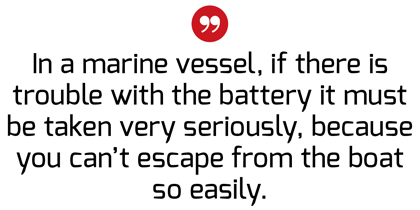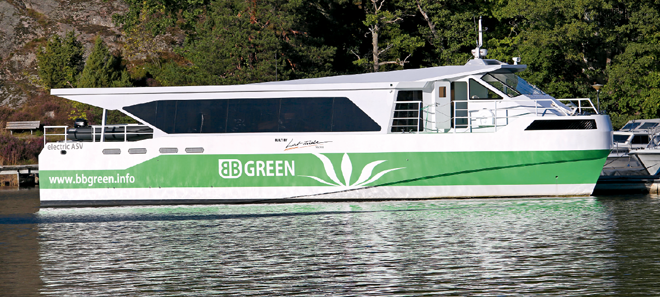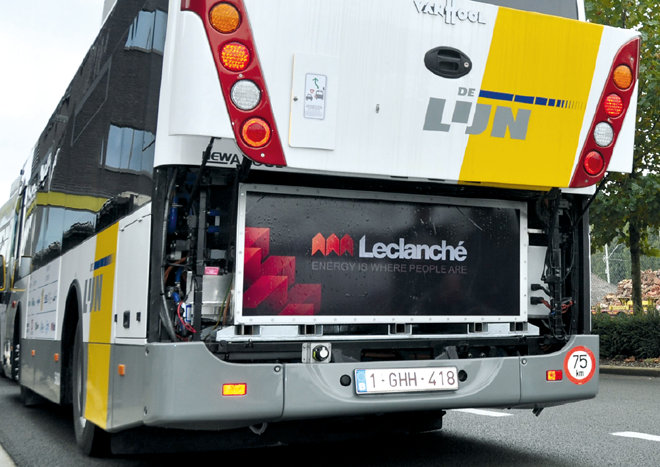The advantages of electrifying transportation are far-reaching. Advanced energy storage systems are even making their way into the commercial marine industry. There are many marine applications in which adding a large Li-ion battery pack makes a lot of sense.
The best-use case varies depending on the boat size and purpose. All-electric ferries, for example, are being deployed in different areas, largely driven by regulations. There are some sensitive harbors that require all vessels to be low-noise and pollution-free. And if there is a need for a ferry with a range of about 20 nautical miles or less, going all-electric works great.
There are also a few growing niches for hybridization and load optimization. Boats that need to operate in the heavily-regulated zones but also have long range capabilities can be designed with a PHEV-like drivetrain – traveling short distances on battery power and running diesel engines outside of restricted areas.
Other marine duty cycles can benefit greatly from a hybrid propulsion system – tugboats, for example – reducing fuel consumption and cutting emissions by up to 35%.
Also, some of the world’s largest vessels are realizing a clear financial payback by converting their existing auxiliary loads to an aftermarket hybrid system – running a genset (diesel generator) in its most efficient range, coupled with a battery pack.


One-stop shop for power and energy
To meet all the different use cases for advanced marine battery packs, engineers usually choose between a variety of Li-ion cell formulations that have either higher energy or higher power capabilities.
Leclanché is a European manufacturer of both power and energy cells, headquartered in Switzerland with cell manufacturing in Germany and offices in Belgium and the US. In fact the century-old company is the only manufacturer of both lithium-titanate (LTO) and graphite-NMC cells on the Continent.
Graphite-NMC is a Li-ion technology that’s often used in passenger EVs because its high energy density provides the longest possible range. LTO is capable of very high charging power, so it’s used in applications where regular fast charging events are expected.


“We’re known for our Swiss engineering and German high quality, but also, being the sole European player is actually a great asset for us,” Antti Vayrynen, Leclanché’s VP of Electrified Transportation, told Charged. “Transporting batteries is difficult because of safety regulations. Particularly transporting batteries by air freight – it’s not impossible, but having multiple European offices is definitely an advantage.”
Leclanché’s cells are used in a variety of stationary storage applications. In transportation the company is focused on three segments: commercial marine, on-road vehicles (mainly buses) and industrial machinery such as mining equipment.
The company is not simply a manufacturer of cells. It also designs and manufactures full Li-ion powered systems for most applications. “We actually have more electrical, software, and mechanical engineers focused on system design than chemists working on cells at this point,” said Vayrynen. “When we go to customers we don’t just try to sell them Li-ion cells. We start with advanced simulations of their application to find out what kind of cell will work best: high-energy graphite-NMC or high-power LTO. Then we help to design a complete system solution.”


Designed for the sea
In some ways, marine conditions are quite friendly for designing Li-ion battery packs. The temperatures of the storage compartments are generally constant and not too high. Vayrynen says Leclanché designs marine packs with both liquid and air cooling, depending on the application. Typically a boat that’s designed for multiple fast charging events per day will require liquid cooling.
There are also fewer packaging constraints on boats than in on-road EVs, both in terms of volume and weight. Of course, it’s always important to minimize packaging to increase payload, but boats are less sensitive to weight vs range tradeoffs.
There is one aspect of the marine industry that is more challenging for battery system engineers – strict safety regulations. “In a marine vessel, if there is trouble with the battery it must be taken very seriously, because you can’t escape from the boat so easily,” said Vayrynen.
Late last year some classification societies released new battery-specific safety requirements, including a lot of safety analysis and fire propagation testing. In the unlikely event of a battery fire, the goal of the new regulations is to make sure the problem stays within one battery module and doesn’t spread throughout the pack or further.


“Achieving product certification for these types of regulations involves detailed safety and hazard analysis, and a lot of testing,” said Vayrynen. “During our current work on an electric ferry project for Denmark, Leclanché is gaining certification for our marine product line. It’s a scalable module system, and now with this rigorous safety approval we can use it in all marine applications.”
Denmark E-Ferry


Leclanché describes the Denmark E-Ferry as the company’s flagship project. The EU-funded vessel is the world’s largest fully electric ferry, and will be brought into service in November 2017. It will transport up to 198 passengers and 31 vehicles between the island of Ærø and the Danish mainland.
The electric drivetrain of the ferry comprises two parallel, fully redundant parts, which increases safety and reliability. The e-ferry will reach speeds of up to 14 knots – faster than existing boats of similar size. The enormous battery pack contains 4.3 MWh of graphite-NMC cells, providing a range of about 20 nautical miles between charges.
The BB Green ASV


In May, Leclanché was one of eight partners that worked together to launch the first all-electric Air Supported Vessel (ASV) in Riga, Latvia. The 25-ton ship, named BB Green, reduces water resistance with a battery-powered fan in the bow that injects pressurized air into a cavity under the ship. The air cushion supports about 80 percent of the vessel’s displacement, reducing resistance by 40 percent at high speed. The system enables the ship to reach a speed of 30 knots, propelled by two 280 kW electric motors, and claim the title of “the world’s fastest electric commuter vessel.” The hull and propulsion system was made by Echandia Marine and SES Europe.
BB Green currently runs on a Leclanché-built 200 kWh LTO battery – but it’s designed to be upgraded up to 400 kWh. The boat’s current configuration enables it to operate at high speed for over 30 minutes with a 14-nautical-mile range. At each stop, the LTO pack is fast charged for 15 to 20 minutes.
The vessel holds up to 70 passengers plus bikes, and is initially being used for demonstration purposes across Europe.


Charging dock
Large marine battery packs require an equally large amount of charging power. Vayrynen explained that the charging operations must be automated. “The power is so high that any equipment would be difficult for people to handle. It’s also critical that charging is very safe and trouble-free. It must be connected quickly, because the time that you’re in the port is very valuable.”
The 200 kWh LTO battery in the BB Green ASV currently charges with a peak power of about 800 kW, and when the second half of the pack is installed the power will double.


The 4.3 MWh graphite-NMC pack in Denmark’s E-Ferry charges with a peak power up to 4 MW.
“In some cases Leclanché works with partners to develop the charging system for customers,” said Vayrynen. “But we also have the knowledge and network to provide the chargers ourselves. In fact, we’re quite vertically integrated and can design and supply the whole system – battery, driveline and chargers.”
Land/sea synergies
On the road, one of Leclanché’s core focuses is electric and hybrid buses. “We work closely with some big bus companies,” said Vayrynen. “Hybrids are a first step for some customers, but the biggest potential for financial savings is all-electric.”
Leclanché sees a few electric bus hotspots in cities that have ambitions to be emissions-free, including London and Paris, which recently announced a plan to transition a major part of its bus fleet to electric.


Supplying both LTO and graphite-NMC is also an advantage for the bus market, in which Vayrynen describes a complicated process of helping customers design an electric ecosystem. “Many cities like the idea of having opportunity charging along the routes and using LTO packs that are fast charged many times per day. This allows for a smaller battery investment because you can use smaller packs that are charged more often. However, the investment in the charging infrastructure is higher because it’s in more locations. So to decide which kind of fleet is best for a city is quite a big optimization problem. It depends on what kind of roads you have, how fast you can build up the infrastructure and how much you can invest in a given timeframe.”


Typically, a Leclanché battery pack designed for en route charging will contain between 50 and 80 kWh of LTO cells. For long-range buses designed for overnight charging, a graphite-NMC pack will be between 200 and 300 kWh.
Leclanché says that the core building blocks of its battery packs are the same for any application. “Our module design contains the BMS and up to 32 cells,” said Vayrynen. “That remains the same – what changes is the larger box that comprises the pack. For marine use, this is a scalable rack that also has the fire suppression system. In buses it’s usually defined by the customer’s existing platform. But the ability to use the same basic technology that crosses over many applications allows us to design efficiently. It’s very helpful as we work on many different projects in our pipeline.”
This article originally appeared in Charged Issue 28 – November/December 2016. – Subscribe now.


















































